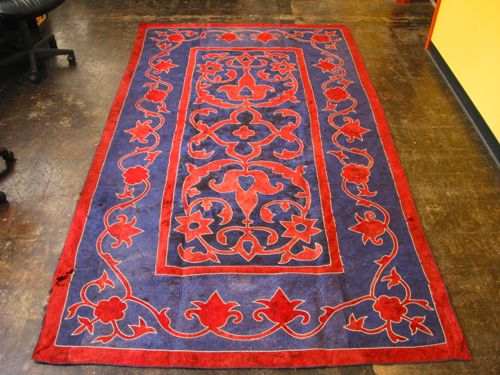
Posted by Oliver Perrin on 05-17-2002 02:06 PM:
Avar/Daghestani Felt Rugs
Hello everyone:
I'm new to this forum, so please forgive me if I post in the wrong place. It is, however, my understanding that
this area is set aside for discussion of images of textiles.
I recently aquired this piece, which the dealer believed was a Kyrgyz felt. Based on the motifs present, it is
my belief that it clearly is not. It shows an obvious relationship to the metalwork of the Eastern Caucasus as
seen in nielloed silverwork on the arms of Daghestan from the 19th and early 20th century.
Has anyone seen work like this before? I'm interested in discussing these rugs and turning up images of similar
ones. Any assistance or suggested resources would be greatly appreciated.

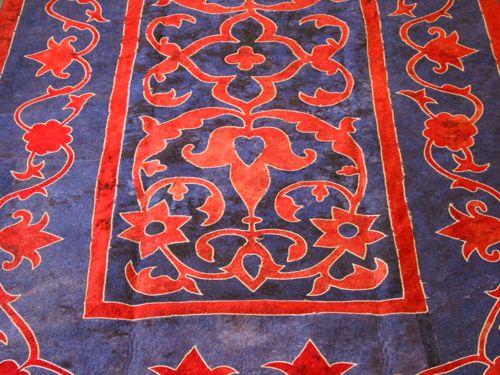
It appears to be late 19th century and measures 122" x 70".
If you are interested in discussing this piece, you can contact me at oliver@monumental-i.com.
This is not a commercial posting. This piece is not available for sale.
Best Regards,
Oliver
Editorial Note: I don't want to discourage anyone from
contacting Oliver, but would be very glad to see the piece discussed here as well.
Dear Oliver,
You are quite right.
On Wright & Wertime’s book "Caucasian Carpets and Covers" there is a photo of a Daghestan felt very
similar to yours (page 54 plate 17). I have no time to scan it now, I’ll do it tomorrow.
Regards,
Filiberto
Mr. Boncompagni:
Thank you for your kind reply. I collect Caucasian arms and armor and I've long wished to positively identify textiles
from the region (Northern Caucasian highlands) other than Tcherkesskas with silver galloon and cartridge pockets.
If you do have time to scan and post the image it would be greatly appreciated. I'm trying to find examples for
comparison's sake (primarily in an attempt to date this one).
I'm also interested in positively identifying "Circassian" textiles as well, if identified examples exist.
If anyone needs assistance identifying metalwork or arms and armor from the region I'd be happy to help.
Thank you again for your reply.
Best,
Oliver
Hi Oliver,
That's a very neat looking item, and I don't think I've seen one like it. I agree that it is not likely to be Kyrgyz.
It doesn't have a central Asian look at all.
Avar/Daghestan sounds plausible to me, but other attributions would, too. Wertime and Wright are meticulously accurate
people, and if they attribute the one in their book to Daghestan there is a high probability that it came from
there.
Regards,
Steve Price
I don't know much about Felt, only know the ones made in Anatolia.
I have seen similar one, don't remember where it was. Just sending you the copy of this image. But, I am sure that
it is not the same quality.
Regards
Muammer UCAR
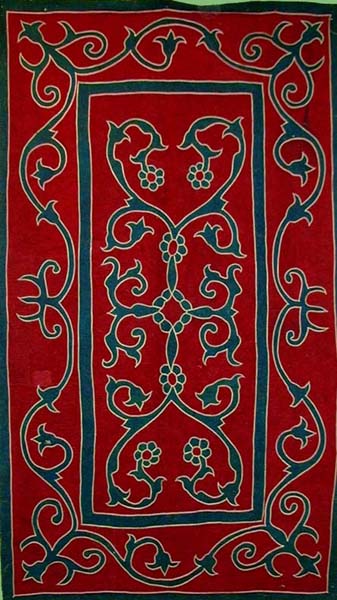
Muammer Bey:
Yardim icin ve fotograf icin cok tessekur ederim. Cok naziksiniz. Genelde, daglarin halilari ile ilgili bilgi bulmak
bir az zor.
Forgive me if my Turkish is a bit rusty!
This form of felt is very interesting to me because it is almost certainly *not* intended for export. This means
it is less likely that it has been influenced by the tastes of an export market. Furthermore, the motifs across
the surface of the rug are very, very closely paralleled, as I mentioned earlier, in metalwork from the region.
The felt shows what appears to be Circassian influence in the relatively open execution of the vine and trefoil
motifs, etc.. In general, the Eastern Caucasus usually shows strong Iranic influence as well as baroque European
affectations that lead to a rather "florid" and busy execution in metalwork best seen in examples from
Kubachi.
Of course, Circassian infuence on the whole of the Caucasus may clearly be seen in the adoption of Tcherkesska
throughout the region.
What is so interesting about this is that it shows a clear "Turkic" influence and is obviously related
to felts produced further East, however it has large central elements rather than smaller, repetitive units.
I'm rather ignorant where textiles are concerned though, and so I'm trying to gather information to place it geographically
with more precision.
I'm also interested in how I might mount it for display on a wall (provided discussion of this is not out of place
in this forum). Any mounting I undertake would have to be reversible. Any ideas for safe ways to mount it for horizontal
display on a wall.
Thank you all for your input and assistance!
Best,
Oliver
Hi Oliver,
For mounting, I offer two suggestions. First, strips of carpet tack screwed into the wall might work, although
you'll have to be careful when putting it up or taking it down not to pull too much of the felt off. Better, sew
a Velcro strip near the top (loose basting works just fine). Glue the mating Velcro to a wood slat, and screw it
into the wall. This is nondestructive, and the reverse side can easily be shown.
Regards,
Steve Price
Dear Oliver,
You arrived to Caucasian textiles after collecting Caucasian arms… Well, it seems I’m taking the opposite direction
after I bought this dagger in silver and niello:
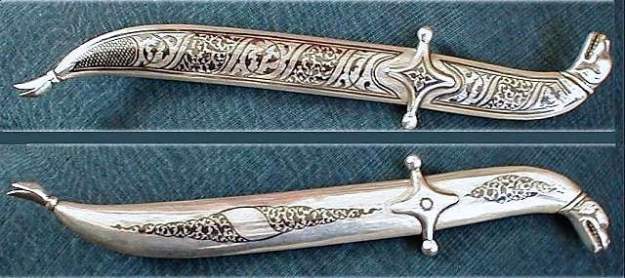
I am told this should be from the Kubachi village, famous in Daghestan for its silversmiths. My guess it’s at least
80 years old.
Now the image I promised you:
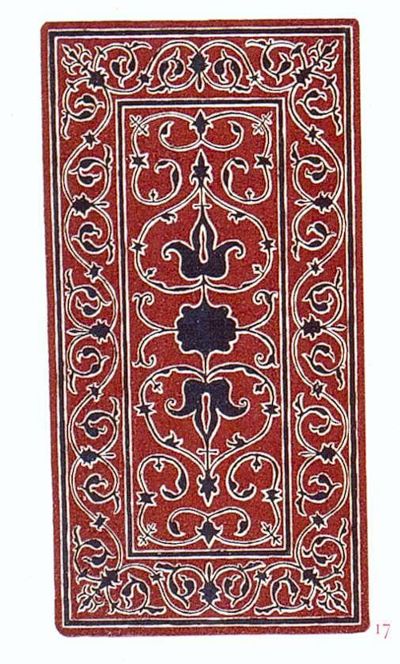
The caption is: Daghestan felt, 1913 photograph.
Wright and Wertime attribute this felt to the Kumiks ethnic group and they say that "Kumiks have been in Daghestan
since the 7th century. They arrived from Central Asia via the steppe north of the Caspian Sea, and are probably
the only Turks in Caucasia who came without exposure to Iranian culture."
The dagger decoration and the felts are indeed similar. Notice, though, that the Kubachi villagers belong to the
Darghins group (like the Kaitags!). So, which one influenced the other?
I was curious and I searched the web for images of silver and niello artifacts. I found that in neighboring Georgia
they used the same style of "vine" decoration. But I found also this:

Silver & Niello Box, Toledo, 11th Century.
Toledo: pretty far from Caucasus, right?
Browsing a book of Art History on the origin of the Islamic Art I found that the vine decoration could come from
Coptic Egypt and later passed in Sasanian Persia… and so on.
Speaking about Egypt, if you pass through Cairo, go to the 10th-century gate of Bab Zuwayla, cross the small square
in front of the gate and you are at the beginning of one of the oldest thoroughfares in Cairo - Shari Khayyamiya.
Khayma means "tent" in Arabic and here, in the Street of the Tentmakers, the ancient craft of making
huge tent pavilions, or suradeq, out of appliqued cloth patterns has been carried on for hundreds of years.
This style of decoration is, again, similar to the one I’m discussing here. Right now, I’m sitting on a suradeq
cushion we bought there!
Regards,
Filiberto
Hi again,
Oliver mentioned the Tcherkesskas.
It is the name of the Circassian garment that was adopted all over the Caucasus and later became the Cossacks’
uniform.
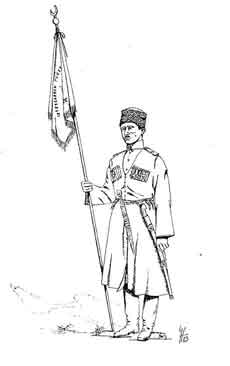
Regards,
Filiberto
Hi People,
I just want to call your attention to the fact that the image to which Muammer Ucar referred a few messages up
has been added to his post.
Regards,
Steve Price
Mr. Boncompagni:
Thank you for posting images of the felt. It does seem to be very similar to the one I've found, though it seems
more baroque and refined in its execution. The image you posted shows clearly that the background is red. However,
I cannot really see the other color. Can you tell what color the split palmettes and the rest have been done in?
I've found a few more of these felts. One, which I found online has been identified as "Avar". The piece
is dated 1900, but I feel that to be just a bit early.
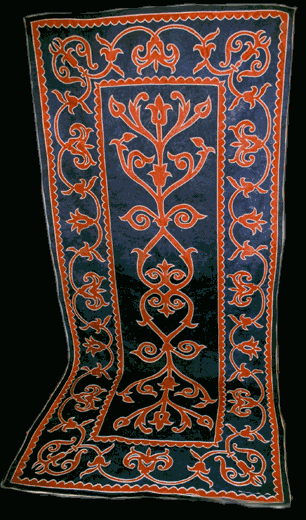
A colleague sent over this image as well, which appears a bit less refined and less symetrical in execution. It
does seem to be of the same general sort.
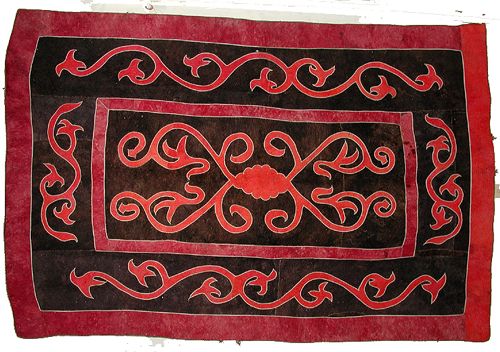
As far as I've been able to tell, the Kumyks are indeed a Turkic people occupying part of the Daghestani lowlands.
Their historic capital was apparently Tarki, a hill now in the suburbs of Makhachkala. They seem to have been most
numerous in the lowlands. However, in the 30s, Avars from the mountains were resettled in historically Kumyk areas.
Pinpointing one specific ethnic group as the source for a particular expression in material culture can be difficult
when it comes to Daghestan. While the mix of ethnicities and languages in the area is well known, there seems to
have been a general mountain culture within which these sub-groups operated. Jews of the Caucasian highlands, for
example, wore Tcherkesskas and carried arms, fighting sometimes with, and sometimes against, their Muslim neighbors.
The Kumyk attribution sounds very likely.
The image of the box you posted is interesting. Thank you. I think it most likely that this is Seljuk work. Thank
you also for mentioning the street of the tent makers. Given that felt was used extensively for Turkic dwellings
there is a great deal to go digging around in there. Of course, felt applique and "mosaic" work would
be present not only in floor coverings, but in a variety of domestic applications. Perhaps some will turn up.
I've also included images of a tcherkesska of about 1900 with ivory cartridge tubes and belt mounts. Finally, I've
posted a detail of the mounts of a Caucasian saber from the same area and time frame as the felt I originally posted.
The comparison is interesting.
Best,
Oliver Perrin
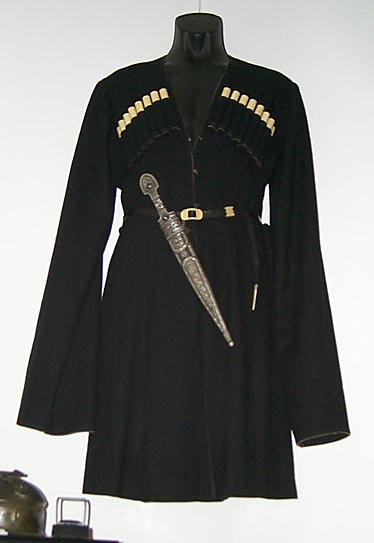
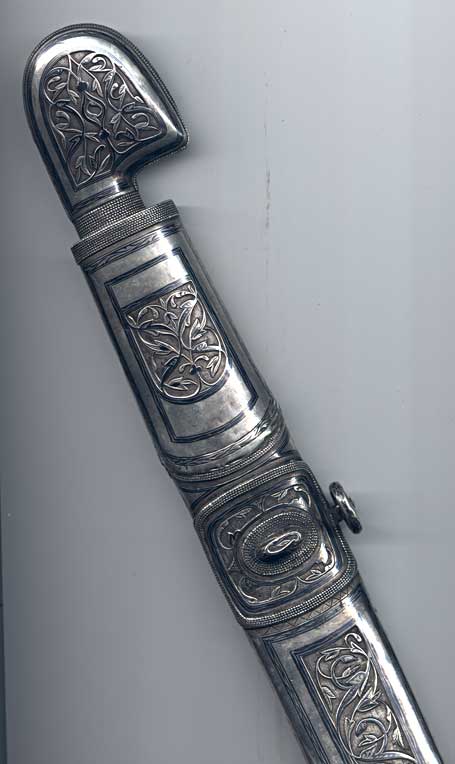
Dear Oliver,
First the answer to your question: the color of the design appears to be black on red background.
You said: pinpointing one specific ethnic group as the
source for a particular expression in material culture can be difficult when it comes to Daghestan. Right. The same could be said about the rest of Caucasus and the Asiatic
countries with tribal weaving tradition!
Anyway, when a couple of months ago I learned about the gazyris (the fake cartridges that go in the chest pockets
of the tcherkesska - I also bought a few gazyri caps in silver and niello), I searched the web for information
on the Circassian people.
It seemed to me that if they influenced the peoples of Caucasus and the Russian Cossacks on men’s "fashion",
arms and warfare, they should also have left more traces in other fields, like textiles and metalwork.
Furthermore, I’m living, albeit temporarily, in Amman which was almost "re-founded" by a group of Circassians
resettled here by the Ottomans after the Circassian Diaspora at the end of the 19th century. So, I wanted to know
more.
I found several links and articles, but absolutely nothing on textiles or other applied arts.
I’ m wondering if you know more about it.
About the 11th century Toledo box, I don’t think it’s Seljuk work. The Umayyads of Cordoba encouraged luxury arts,
such as Goldsmith and Silversmith. Besides, the title of the web page where I found it is: Art and Architecture
of Andalus.
I wonder if those felts are just uncommon or simply they don’t reach the market in noticeable quantity… Muammer,
please, could you supply more information about the ones from Anatolia?
Regards,
Filiberto
By the way, Oliver, nice Shashka!